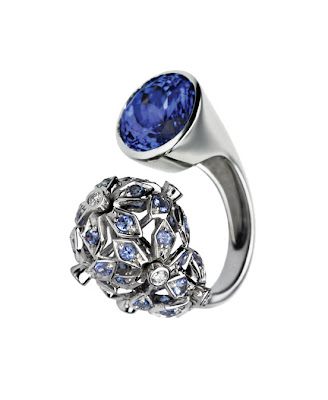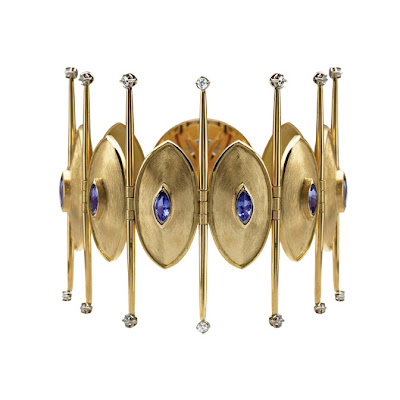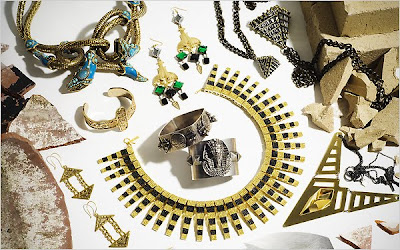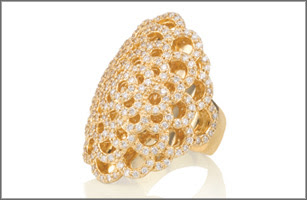 Sabine Roemer
Sabine RoemerSabine Roemer’s ring was inspired by the vivid blooms of a blue-violet wreath flower which, like tanzanite, is unique to the country of Tanzania. Sabine wanted to combine these two gifts of nature into a piece that is both organic and refined.
 Ruth Grieco
Ruth Grieco
Ruth Grieco has created a captivating, versatile piece which like many of her designs can adorn the body in different ways, here being both a brooch and a necklace. For Ruth, tanzanite’s changing blue-violet hues capture the mystery of maternity, and her piece is a magnificent celebration of tanzanite’s spectrum of colors. The detachable tanzanite drop lends movement, whilst the elongating effect of the diamond leaf forms give the piece a grace and fluidity, allowing it to fall perfectly whichever way it is worn.
 James Powell
James Powell
Delicate and richly detailed, James Powell’s design evokes the traditional motif of a stork delivering a baby.
But instead of a stork, James has created two exotic, ethereal hummingbirds that hover watchfully above their precious cargo. A stunning tanzanite drop represents newborn baby, and the cherished gift of new life.

Maria Canale for Suna Brothers
As with many of her designs, Maria Canale drew on nature’s inspirations for this pendant. The beauty of the changing seasons is captured in the opaque backdrop of a frozen lake, re-created through the innovative use of a circular optical lens. Graceful etchings depict fallen leaves trapped just beneath the water’s surface, whilst a dazzling tanzanite in deepest blue rises through the ice as a symbol of vitality and new life. When worn, the lake’s diamond circle is anchored to the necklace through a delicate chain of leaves, but the tanzanite appears to float, suspended gracefully against the skin.
 Dima
Dima
Dima’s work is characterized by her instinctive blending of cultural styles and faith symbols. In these hoop earrings, crafted in Egyptian beaten gold, she intertwines the story of the Maasai’s traditional affinity with blue as the color of fertility with the biblical depiction of the snake in the Garden of Eden. As the snake coils sensually around the hoop, the tanzanite drops from its mouth, symbolizing the fruit of temptation.
 Zoltan David
Zoltan David
In Zoltan David’s winning necklace, flawless technical craftsmanship brings to life a richly detailed, timeless design. Zoltan’s “Flowerfly” captures the vitality of a flower in full bloom. The signature metal ornamentation technique that is Zoltan’s patented creation adds depth and texture to the wings and petals that flank a rare and spectacular matching pair of trilliant cut tanzanites.
 Rodrigo Robson
Rodrigo Robson
Entitled “Start,” Rodrigo Robson’s necklace is a bold, contemporary exploration of the Be Born to Tanzaniteä theme. Highly innovative and original, Rodrigo’s design features real ultrasound film to portray in a modern, literal form the ever-inspiring miracle of new life. His circular links evoke the unbreakable bond between mother and child, whilst tanzanite, the precious gemstone of the present generation, perfectly completes this youthful celebration of birth.
 Stephen Webster
Stephen Webster
Best known for his striking designs that bring out the fire in unique and exotic stones, Stephen Webster needed no greater inspiration than this 29 carat heart shaped tanzanite in deepest midnight blue with flashes of red. With Stephen’s signature edgy, contemporary touch, the traditional symbol of love becomes a show-stopping statement of passion. Highly stylized scrollwork set with diamonds give this classic cut a look that is spectacularly rock ‘n’ roll.
 Ginny Dizon
Ginny Dizon
In creating her cuff bracelet, Ginny Dizon drew her inspiration from the Maasai legend of tanzanite’s discovery, where a bolt of lightning set the land ablaze, transforming crystals on the ground into shimmering blue-violet gemstones. When the last cinders dissolved into the earth, awestruck Maasai tribesmen filled their pouches with the extraordinary gems, intuitively knowing that they would bring about a better life. Ginny’s cuff bracelet captures the drama of the lightning, whilst her use of both rough and facetted tanzanite symbolizes the journey each stone takes from its raw state in the earth to its final polished perfection. In Ginny’s interpretation, the theme “Be Born to Tanzaniteä” becomes a story of discovery, and a celebration of the natural miracle of this rare and elusive gem.
 Colin Waylett
Colin Waylett
Colin Waylett’s stunning arm cuff is evocative of the noble traditions of Tanzania’s proud Maasai people. The interlocking shields represent the unity of warrior tribemen returning at sunset from a hunt against a blue and golden sky. The glinting of the last drops of sunlight catching the tips of the tribesmen’s spears is captured in the cuff’s diamond tips.
 Laurence Ratinaud
Laurence Ratinaud
Laurence Ratinaud’s unique ring was inspired by the creation of life before birth. White gold is elegantly crafted into a mesh egg shape representing conception. It holds and protecting within it a simple tanzanite oval that signifies life itself. Laurence’s piece symbolizes both the simplicity and its fragility of the seed of new life, showing how something that becomes so infinitely complex can at its earliest moments be held in the palm of the hand.
 Claire Woolley
Claire Woolley
The universal and iconic image of the stork delivering a newborn is captured in Claire’s pendant. A beautiful tanzanite drop, representing the child, is delicately suspended from the necklace’s abstract depiction of the stork in this simple, graceful interpretation of the theme.
 Talento Joias
Talento Joias
Talento Joias’ delicate, distinctive necklace combines twirling strands of tanzanite beads with polished tanzanite ovals set in starburst diamond clusters. Representing hope and life, its designers’, Rachel Tavora and Renata Bessa (featured above), were inspired by the Greek myth of the first woman, Pandora. Created under the direction of the god Zeus, Pandora was a poisoned gift to mankind. According to myth, Pandora was tempted by her curiosity to open the forbidden box given to her by Zeus. In doing so, she released all of mankind’s miseries locked inside, closing the box only in time to capture hope. Although paradise seemed lost, the myth ends with hope’s survival, showing that even in the bleakest of times, so long as hope survives, mankind keeps its chance to be re-born to a new and better life.
 Maria Webster for Boodles
Maria Webster for Boodles
Maria Webster’s graceful birth pendant for Boodles was inspired by the precious bond between mother and child. Fashioned in platinum and encrusted with diamonds, Maria’s pendant represents the cradling arm of a mother as she nurtures her baby.
 Louis Mariette
Louis Mariette
Louis Mariette’s spectacular design, fittingly entitled “A Dream in Africa,” was inspired by memories of his own childhood in Africa. Louis describes this as a dazzling assault on the senses, from the vibrant colors of exotic flowers in bloom to the jumble of semi-precious stones and crystals he would collect to create handmade bracelets and necklaces for his friends and neighbors. Louis’ tanzanite adorned headpiece is a vision of exuberant flowers, handmade in painted resin using a specially developed technique. Twirling metal work is encrusted with pink and lilac pearls, and on the largest cluster nestle sparkling tanzanite gemstones. Louis set the gemstones so that they would sit at the center of the wearer’s forehead, to signify the birthplace of all creativity, a person’s ideas, thoughts and dreams.
 Sevan Bicakci
Sevan Bicakci
Sevan Bicakci’s extraordinary tanzanite ring was inspired by the traditional Tales of One Thousand and One Nights. In this tale, part of a frame story (stories within a story) the wives of the Sultan Schahriah live to see only one dawn after marriage because he has them beheaded the morning after their wedding night. However, his new wife, Princess Scheherazade, outruns her fate by telling the Sultan a new story each night, always stopping at the most exciting point so that he will let her live until the following evening. The ring re-creates the atmosphere in which Princess Scheherazade weaves her magic, enthralling her audience with her tales of mystery and adventure. In this way, the characters Aladdin, Ali Baba and Sinbad the Sailor were born, and in bringing them to life, the Princess earns her nightly reprieve, and survives to see another day.

Shaun Leane
Shaun Leane’s ring, innovative in design and breathtaking to behold, is set with a 10 carat tanzanite centerstone around which flows a coil of pavé set ocean blue sapphires. The tanzanite cleverly locks together with interchangeable bands designed to complement its magical and mysterious qualities. Shimmering natural black diamonds capture its intangible energy, whilst shimmering white diamonds intensify its refreshing brilliance. While the white diamond band is to wear by day, the black diamonds are perfect for evening.
 Arabel Lebrusan
Arabel Lebrusan
Arabel Lebrusan’s delightful, unusual earrings were inspired by the crochet work women in her native Spain use to create baby clothes and crib linen for newborns. The combinations of different thread structures with the resulting variety of forms and finishes are reflected in Arabel’s blending of white gold, silver and enamel to create the fans, swirls and teardrop forms in her feminine piece.
 Stuart Weitzman and Le Vian
Stuart Weitzman and Le Vian
The Stuart Weitzman and Le Vian pair of evening shoes are true show-stoppers: a $2 million dollar creation in glistening silver leather embellished with over 185 carats of tanzanite and 28 carats of diamonds. Stunning ankle bracelets are set with museum quality tanzanite gemstones, painstakingly matched and cut by Le Vian’s master craftsmen, each crowned with a spectacular 16 carat, sparkling tanzanite drop which adorns the front of the foot. The shoes are balanced with a delicate diamond front strap that perfectly complements Stuart Weitzman’s timeless, elegant shoe design.
 Kwiat
Kwiat
Janice DeBell’s tanzanite earrings for Kwiat were inspired by a desire to celebrate the gemstone’s unique spectrum of colors, from shimmering lilacs to deepest blue-violet. Juxtaposing trilliants and ovals, Janice has created a look that is powerful and full of drama, echoing the form of a traditional African tribal spear but with an aesthetic that is edgy and modern. But there is a final, unexpected touch of old-school glamour: turn over each spear and you will find a delicate dusting of diamond micro-pavé.
 Charlotte Ehinger-Schwarz 1876
Charlotte Ehinger-Schwarz 1876
Charlotte Ehinger-Schwarz’s extraordinary necklace is a tribute to the abundant geological landscape and the magnificent native wildlife of the country of Tanzania. A giraffe, elephant and ape nestle among precious rubies, tsavorite and zoisite. A detachable diamond drop carries the necklace’s centerpiece: a dramatic 25 carat marquis cut tanzanite.
source :
tanzanitefoundation.com



































































